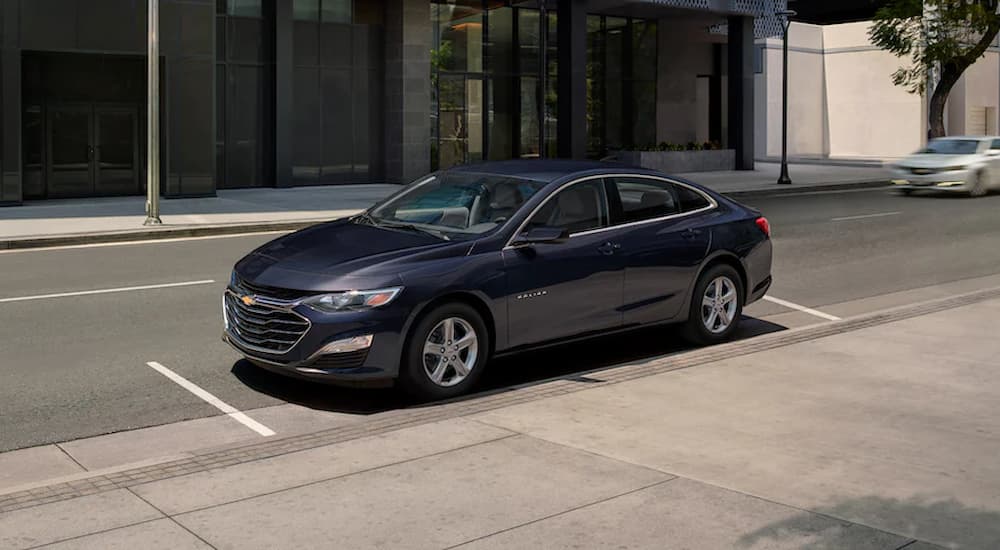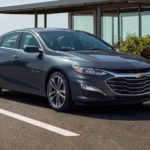Chevrolet has a long history of beloved vehicles. Each of them weaves to represent a tapestry of American automotive history. Here, in the new millennium, certain Chevy models such as the 2022 Corvette need little-to-no introduction. The 2022 Chevy Malibu, though, may be a different story. Who bothers to remember what came before this car, the only sedan in the Chevrolet lineup?
The Corvette and Camaro are instantly recognizable to the average person—and both names are synonymous with the high-performance muscle car. However, the unique histories of other vehicles may only live on in the minds of aficionados and enthusiasts.
One of these is the Chevrolet Malibu. As the latest Malibu makes its rounds at various dealerships and finds its way into the driveways of many American homes, the lineage that belongs to this particular vehicle might be of interest to some of its owners. Pull up a chair and get ready to expand your mind; we’re about to take a journey into the past as we explore the history of the Chevy Malibu.
Humble Beginnings: 1964-1973
While the Malibu is known as an economical sedan, this wasn’t always the case. The first Malibu was a subdivision of the Chevrolet Chevelle, which also happened to be Chevrolet’s very first muscle car. Rolling off the assembly lines in 1964, the Malibu came in a variety of models that catered to an even wider variety of drivers. A 4-door sedan, 2-door hardtop, 2-door convertible, and station wagon configuration were all available. The Malibu line was almost an overnight success, with hundreds of thousands of units sold in the first year alone.
It was the Malibu SS that made the deepest impact on the American public. The two-door sport coupe could be equipped with a 327 small block motor, which could generate 300 horsepower—an impressive figure for the time. It was clear that Chevrolet had something special on their hands; producers of other muscle cars of the time period took notice.
The following year saw an improved 327 engine (5.4L in modern classification), whose horsepower now extended to 350. As the popular adage “go big or go home” challenges one to do, Chevy took the Malibu SS to new extremes in 1966. The “go big” in this case was a new, 396-cu.in. big block engine. At the start of the vehicle’s second generation—in 1968, the Malibu had a significant change that saw it adopt a fastback design. A new engine also came into the picture in the form of a 307 small block, which generated 200 horsepower. It was also around this time that the 327 small block engines were replaced by the more popular 350 small block.
The longevity of this motor can still be seen today, as they’re still manufactured on a much smaller scale for enthusiasts. It was only in 2003 that GM discontinued the use of the 350 in their fleet. By 1970, the Malibu was the only Chevelle still in production, though the SS 396 and newer SS 454 were still available.
Heading Off into the Sunset: 1974-1983
Some car historians consider 1974 to be the final year of the genuine “muscle car”. While some models such as the Camaro and Mustang would continue production in various forms, change was certainly in the air.
Throughout the years 1973 to 1979, massive gas shortages had a tremendous effect on the American economy. As a result, the need for smaller and more fuel-efficient vehicles took priority. By 1978, the Chevelle name was officially dropped in favor of the Malibu, a redesigned and rebranded machine.
While the Malibu would enjoy a brief life in NASCAR, it was apparent that the glory days of the Malibu as a formidable muscle car were no more. The final incarnations of the Malibu came in the form of a two-door coupe, a four-door sedan, and a station wagon. Perhaps the rebranded, more efficient Malibu failed to excite or muscle car enthusiasts felt betrayed; nonetheless, Chevy took notice. The final model year for the Malibu would be 1983—at which point the Chevrolet Celebrity and later the Lumina would take its place.
Rebirth of an American Icon: 1997-2007
Depending on whose opinion you accept, the latter half of the 1990s was a tumultuous and confusing decade. It was an age of irony and impeachment, accompanied by a cavalcade of fashions that by today’s standards seem laughable and ludicrous. This unique and sometimes maligned time period would also bear witness to the rebirth of the Chevy Malibu. Despite being absent from the public consciousness since 1983, the car made its return for the 1997 model year.
To Chevrolet’s credit, they didn’t attempt to reinvent the glory days of the Chevelle, nor did they attempt to replicate the high performance that the Malibu muscle car had been known for. Instead, Chevrolet understood the needs of the many outweighed the needs of the few. In this case, “the many” refers to the average consumer that needed an affordable sedan, one that was affordable and practical for their everyday needs. The 1997 Chevy Malibu (also referred to as the Chevy Classic), replaced the Corsica—and what a worthy replacement it was!
New offerings in the revived Malibu included a 2.5L 4-cylinder engine capable of 150 horsepower, while an available 3.1L V6 was capable of 155 horsepower. To cement the Malibu’s return to prominence, it gained Motortrend’s “Car of the Year” award in 1997. By 2000, the performance of the 3.1L V6 had improved slightly, and now had a horsepower rating of 170. For a vehicle that had been born in the era of the muscle car and retooled for a new age—when economy was widely favored over performance—it appeared that the Malibu chose the perfect moment to make a comeback.
The Saga Continues: 2008-
A little over a decade after the Malibu made its return, the seventh incarnation made a stunning and remarkable impression on the car-buying public. Receiving high grades from both critics and consumers, the 2008 Malibu provided customers the option of a 2.4L 4-cylinder with a horsepower rating of 169, up to a 3.6L V6 with 252 horsepower. This tradition of offering the average consumer solid performance at an affordable price continued in 2016. That year, Chevrolet went from offering customers a 4 or 6-cylinder, to the option of two 4-cylinder engines. This is a trend that continues to the current model year.
Chevy Malibu’s Place in History
Chevrolet has always managed to stay ahead of the curve as far as trends go, and their ability and willingness to adapt to the needs of the public cement them as a strong symbol of Americana. The future of the Malibu is currently unwritten, but it’s safe to assume that Chevrolet will have a significant role in writing it. Even if the Malibu is discontinued after the 2023 model year, as some speculation has suggested, its influence will guide future Chevy models that balance performance and price.
We hope that this information on the continuing changes in the Chevy Malibu has been informative and entertaining. It’s noteworthy how this model has transformed as public demand changed. However, those who wish to become part of the Malibu’s lineage may be short on time. Then again, its final resignation may make the last model year (whenever that is) something of a collector’s item—a relic of what once was.






